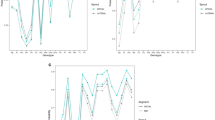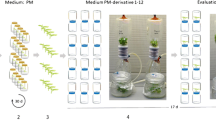Summary
The in vitro culture of potato cultivars (Désirée, Estima, Foxton, Pentaland Squire, Record) initiated from tuber sprout buds has been studied with the requirements of a routine method of micropropagation in mind. Comparisons of the growth of the cultivars on media based on Murashige and Skoog (MS) and on Knop showed that although cultivars differed in their propensity to grow through several generations their performance on MS medium was in general superior. Sprout tips grew slower than buds from lower nodes in the first culture generation but no significant differences in growth were seen in later generations. Thus, where limited numbers of buds from lower nodes are available, sprout tips can be used to initiate cultures.
Zusammenfassung
Die aus Knospen von Knollenkeimen hervorgegangene in vitro Kultur der Kartoffelsorten Désirée, Estima, Foxton, Pentland Squire und Record wurde untersucht im Hinblick auf die Erfordernisse einer Routinemethode für eine Mikrovermehrung. Die Nährmedien wurden wie folgt bezeichnet: M1: siehe Tab. 1; M2: wie M1, ohne Vitamine; K1: siehe Tab. 1; K2: wie K1, ohne Vitamine.
Einige Sorten wuchsen schnell (Désirée, Estima), andere dagegen nur langsam (Record, Foxton) (Tab. 2). Auf dem Medium nach Murashige und Skoog (MS) was das Wachstum allgemein besser als auf dem Medium nach Knop. Einige Sorten (Désirée, Estima) wuchsen zunächst in gleicher Weise auf beiden Nährmedien während andere (Pentland Squire) auf MS-Medium auffällig besser wuchsen. Unterschiede zwischen den Sorten wurden besonders deutlich, wenn die Kultur über mehrere Generationen hinweg durchgeführt wurde (Abb. 1). Désirée, Foxton und Estima zeigten während 3 Generationen einen verminderten Wuchs auf Knop's Medium, einen guten aber auf MS-Medium, währmedien in gleicher Weise wuchs. Die Zugabe von Vitaminen zu den Nährmedien beeinflusste nicht überall das Wachstum, aber in einigen Fällen zeigten einzelne Sorten eine Vorliebe für das Vorhandensein oder für das Fehlen von Vitaminen (Tab. 2).
Abschnitte von Keimspitzen auf MS-Medium wuchsen zunächst langsamer als solche aus den unteren Keimbereichen (Tab. 3), aber die Wachstumsunterschiede verschwanden in den Kulturen nach drei Generationen, so dass bei der Verwendung von Keimspitzen die Vermehrungsrate bei denjenigen Sorten erhöht werden könnte, die kurze oder stark verzweigte Keime aufweisen.
Résumé
La culture in vitro de plusieurs variétés de pommes de terre (Désirée, Estima, Foxton, Pentland Squire et Record), à partir des bourgeons issus des germes de tubercule a été testée selon les recommandations d'une méthode de routine pour la micropropagation. Quatre milieux nutritifs ont été utilisés: M1=voir tabl. 1; M2=comme M1 mais sans vitamines; K1=voir tabl. 1; K2=comme K1 mais sans vitamines.
Certaines variétés (Désirée, Estima) ont poussé rapidement, alors que d'autres (Record, Foxton) ont eu une croissance lente (tabl. 2). Le milieu de Murashige et Skoog (MS) a donné une croissance générale supérieure à celle de Knop. Certaines variétés (Désirée, Estima) ont eu au départ un taux de croissance similaire sur les deux types de milieu, tandis que pour d'autres (Pentland Squire) il fût nettement plus important sur milieu MS. Les différences entre variétés sont apparues plus nettement après prolongement de la culture sur plusieurs générations (fig. 1). Désirée, Foxton et Estima ont vu leur croissance diminuer au cours de trois générations sur Knop mais non sur milieu MS, tandis que Record eut un niveau de croissance faible mais identique sur les différents milieux. L'apport de vitamines dans le milieu n'a produit aucun effet général sur la croissance, mais dans quelques cas, on notait une certaine préférence pour la présence ou l'absence des vitamines (tabl. 2).
Les extrémités de germes cultivées sur milieu MS ont eu une croissance initiale plus faible que les entre-noeuds inférieurs (tabl. 3) mais les différences disparaissent après trois générations de culture, de sorte que les extrémités de germes peuvent augmenter les taux de multiplication pour les variétés à germes courts ou à forte ramification.
Similar content being viewed by others
References
Anonymous, 1981. Research Investigations and Field Trials (RIFT) 1980–81. Development of rapid and economic means of multiplying early generations of seed potatoes. School of Agriculture, Aberdeen, p. 175–177.
Bryan, J. E., M. T. Jackson & N. G. Melendez, 1981. Rapid multiplication techniques for potatoes. International Patato Centre, Lima, Peru.
Hussey, G. & N. J. Stacey, 1981. In vitro propagation of potato (Solanum tuberosum L.).Annals of Botany 48: 787–796.
Morel, G. & J. F. Muller, 1964. La culture in vitro du meristème apical de la pomme de terre.Comptes rendus hebdomadaires des séances de l'Académie des sciences 258: 5250–5252.
Murashige, T. & F. Skoog, 1962. A revised medium for rapid growth and bioassays with tobacco tissue cultures.Physiologia Plantarum 15: 473–497.
Nozeran, R., L. Bancilhon-Rossignol & S. Grenan, 1977. Nouvelles possibilites d'obtention et de multiplication rapide de clones sains de pomme de terre (Solanum tuberosum L.).Comptes rendus hebdomadaires des séances de l'Académie des Sciences, Series D, 285: 37–40.
Paupardin, C. & R. Tizio, 1970. Action de quelques composés phénoliques sur la tubérisation de la pomme de terre.Potato Research 13: 187–198.
Roca, W. M., N. O. Espinoza, M. R. Roca & J. E. Bryan, 1978. A tissue culture method for the rapid propagation of potatoes.American Potato Journal 55: 691–701.
Stace-Smith, R. & F. C. Mellor, 1968. Eradication of potato virus X and S by thermotherapy and axillary bud cultures.Phystopathology 58: 199–203:
Author information
Authors and Affiliations
Rights and permissions
About this article
Cite this article
Amirouche, L., Stuchbury, T. & Matthews, S. Comparisons of cultivar performance on different nutrient media in a routine method for potato micropropagation. Potato Res 28, 469–477 (1985). https://doi.org/10.1007/BF02357525
Accepted:
Issue Date:
DOI: https://doi.org/10.1007/BF02357525




